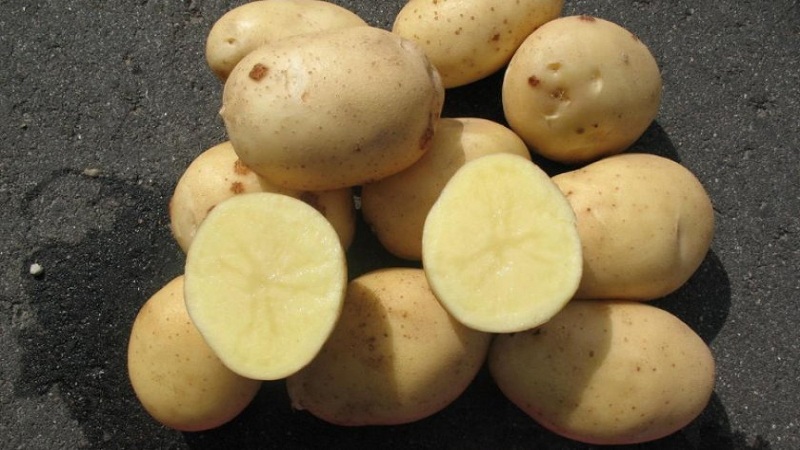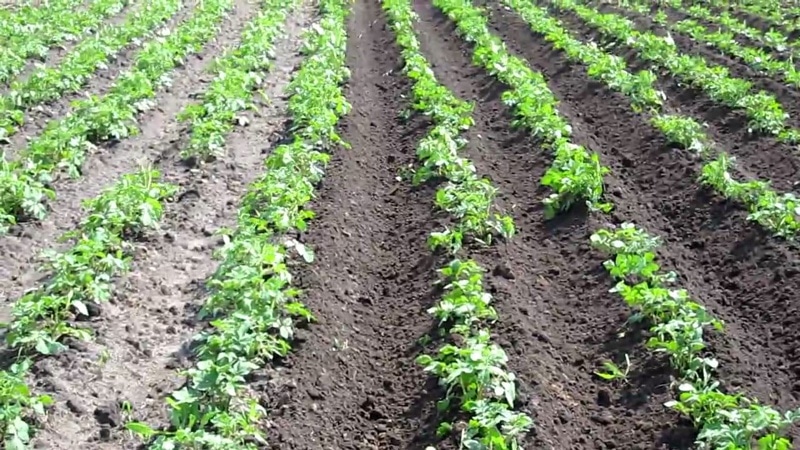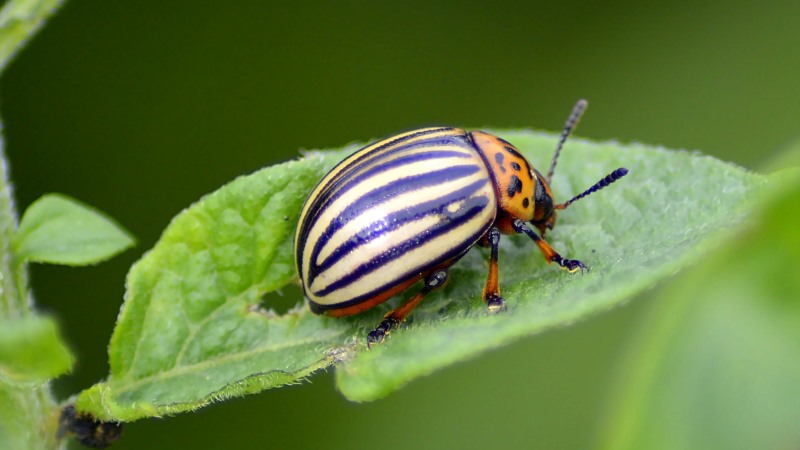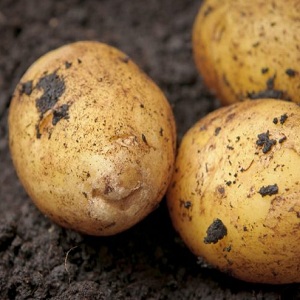Mid-season unpretentious potato variety "Arizona": description of the variety, advantages and disadvantages
Arizona potatoes are among the high-yielding varieties. According to the originator, about 577 kg of selected tubers with yellow skin and pulp can be harvested from 1 m². Despite the short time of existence on the Russian markets, this potato managed to win the love of farmers and consumers due to its presentation, keeping quality, pleasant taste and optimal starch content.
The content of the article
Origin and description of the variety
The mid-early variety Arizona was developed by Dutch breeders of Agrico.
In the photo - Arizona potatoes.

Distinctive features of the culture are presented in the table.
| Indicators | Characteristic |
| Ripening period | 70-80 days |
| Bush | Medium height, semi-erect or spreading type |
| The number of tubers in the bush | 9-10 |
| Weight | 112-150 g |
| The form | Elongated oval |
| Coloration | The skin is yellow, with small eyes, the pulp is light yellow |
| Leaves | Large, green color |
| Corolla color | White |
| Starch content | 13-16% |
| Taste | Good (4 on a five-point scale) |
| Cooking class / group | B (medium friable) |
| Yield | Average rate - 225-408 c / ha, maximum - 577 c / ha |
| Marketability | 88-97% |
| Keeping quality | 95% |
| Appointment | Dining room |
| Sustainability | Immunity to cancer, golden nematode, wrinkled mosaic. The culture is moderately susceptible to late blight of the tops and weakly resistant to late blight of tubers. |
| Transportability | High |
How to grow
The Arizona variety is completely unassuming to care for. It needs to comply with the watering regime, loosening the beds, removing weeds, hilling bushes, applying organic and mineral fertilizers.
Timing, scheme and landing rules
Potato planting time depends on the climatic conditions of the region. In areas with a warm climate, planting work begins in mid-April. In regions characterized by the late arrival of spring, planting is planned for the first decade of May.
Potato beds are best suited to open, sunny, previously grown areas onion, cabbage, beans, peas, greens, lupine, winter crops. The most favorable soil is sandy loam, loamy or black soil.
In the fall, the soil is dug up and fertilized with humus. In the spring, the site is sown with green manure (flax, oats, wheat, rye, mustard), and after 3-4 weeks they are mowed and embedded in the ground. Plants prevent the spread of pathogenic fungi, saturate the soil with nitrogen and air.
River sand, peat, sawdust are added to the heavy, forgotten land. With the help of litmus strips, a special device with a long probe, which can be purchased at gardening stores, the acidity of the soil is determined. The optimal pH is 5.2-5.7. Excessively acidic earth (pH less than 4.5) is deoxidized with dolomite flour, slaked lime, chalk, ash.
Three weeks before planting, the tubers are taken out of storage and taken out into sunlight for landscaping and germination. Potatoes are soaked in growth stimulants 24 hours before planting. Such funds not only increase yields, but also prevent infection with pathogenic microflora. The most common stimulants are Epin and Zircon.
On the day of planting, the prepared holes are spilled with a strong solution of potassium permanganate, and the tubers are treated with the Matador fungicide to protect against the Colorado potato beetle.
The depth of the holes should not exceed 10 cm. A handful of peat mixed with the same amount of humus is added to each of them. The distance between the pits is 30 cm. The row spacing is 60–70 cm.
Reference. The optimum soil temperature for planting Arizona potatoes is + 10 ° C.
Care

Potato care rules:
- Watered once a week until the buds appear, 3-4 liters under the bush by the fractional method: first, part of the water is poured, and after complete absorption, the remains. In a dry season, the frequency of irrigation is doubled and sprinkling is arranged. Water consumption - 12-14 liters. The best way to regulate moisture is to install a drip system.
- The soil is loosened after each watering, avoiding the appearance of a dense earth crust.
- Hilling combined with weeding. This procedure provides additional ventilation of the root system, facilitates the access of moisture. The first hilling is carried out when the sprouts grow by 10-20 cm, the second - after 15-20 days. In this case, the soil must be moist.
- Mulching - additional, but not mandatory procedure. Hay, straw, sawdust, needles are laid out on the beds to delay the vagi in the ground, grow weeds and repel insects.
Top dressing is applied three times per season according to the scheme:
| № | Application time | Fertilizer (per 1 sq. M) |
| I feeding | Immediately after germination | 0.5 liters of mullein and 15 g of urea per 10 liters of water. Consumption per bush - 0.5 l. |
| II feeding | During budding | 15 g of potassium sulfate, 15 g of double superphosphate and 100 g of ash per 10 liters of water. Consumption - 0.5 l. |
| III feeding | During flowering | 30 g superphosphate and 200 ml mullein per 10 liters of water. Consumption per bush - 50 ml. |
The nuances of growing and possible difficulties
New varieties of potatoes do not cause difficulties in growing, even for beginners. Arizona potatoes are no exception. The culture gives the same result in different regions and on any type of soil. In addition to the classical method of planting tubers, the method is used under the straw.
Benefits:
- no need to dig the ground;
- rotted straw is an excellent fertilizer;
- instead of constant loosening and hilling, a new layer of mulch is poured;
- plantings rarely infect fungal and viral infections;
- Colorado beetles and slugs bypass bushes;
- tubers do not need to be peeled from the ground after harvest;
- increasing plant productivity;
- reduction in labor costs.
Potato planting technology:
- In the fall, the site is weeded and dug up.
- Sowing of green manure is carried out, followed by mowing and embedding in the ground.
- The top layer of the soil is loosened, furrows are formed up to 7 cm deep and row spacing 70 cm wide.
- The prepared tubers are laid out in the grooves with sprouts up, sprinkled with ash and soil.
- The straw is distributed over the entire area in a layer up to 40 cm.
- To protect against rodents, a black root is planted on the site.
It is not necessary to water such plantings, there is enough natural precipitation. During the dry period, a drip system is installed on the site.
After the potatoes sprout 5-7 cm, another layer of mulch of 20 cm is placed on top. Plants do not need feeding, they get all the vital substances from straw.
Interesting fact... Potatoes are capable of accumulating solanine, a substance poisonous to humans. To get poisoned, it is enough to eat 1-2 potato berries that form in place of the flower, or 1 kg of raw, unpeeled, green tubers.
Diseases and pests

The Arizona variety is not resistant to late blight of foliage and tubers. The fungus begins to multiply actively in a warm and humid environment, spreading throughout the planting. The first sign of infection is brown spots on the leaves and a whitish coating on the back. When digging, dark spots with rot are found on the tubers.
Unharvested tops and weeds, proximity to tomatoes and eggplants become the source of infection. The fight against the fungus begins at the first symptoms, but it is better to carry out preventive treatment with "Fitosporin", copper sulfate or milk serum with iodine in advance. It is prepared from 15 drops and 1 liter of fermented milk product per 10 liters of water.
For the treatment of plants, fungicides are used: "Skor", "Ditan", "Ridomil Gold", "Bravo", "Reglon Super".
Preventive measures:
- compliance with the rules of crop rotation;
- cleaning of weeds and plant residues;
- sparse landing;
- control of nitrogen levels in the soil;
- feeding with potassium-phosphorus solutions;
- hilling bushes;
- mulching beds with straw, hay, sawdust.
There is evidence that Arizona is affected by fungi that cause common scab. The disease can be detected only after digging the potatoes, since the pathogen only affects the tubers. Rough dark spots of irregular shape appear on the skin. Root crops lose their presentation, taste deteriorates due to a decrease in the percentage of starch.
Scab develops in dry, hot weather, with a lack of moisture in the soil.
Help fight fungus:
- mineral fertilizers (2 tbsp. l ammonium sulfate per 10 l);
- rejection of tubers with signs of infection during planting;
- regular moistening of the soil at the budding stage;
- crop rotation;
- sowing green manure;
- disinfection of tubers during germination;
- spraying of plantings with “Maxim”, “Albit”, “Acrobat MC”, “Mankotseb”, “Ordan”.
In addition to fungal diseases, farmers have to deal with the invasion of Colorado beetles and their larvae, which eat the ground part of the plant. In case of mass infection, pests completely destroy the bushes.
Insects hibernate in the soil and, after warm weather sets in, climb to the surface. If the larvae and beetles are slightly damaged, they are collected by hand in a jar with soap or saline; for large-scale use biological agents "Agrovertin", "Bicol", "Colorado", "Tabu", "Prestige", "Colorado potato beetle NO!"
Folk remedies have proven effectiveness:
- dusting with birch ash, corn flour, gypsum;
- treatment with a solution of birch tar (100 g per 10 liters of water);
- spraying with a solution of ash and tar soap (200 g of ash and 50 g of soap shavings per 10 liters of water);
- processing with walnut infusion (1 kg of green fruits and leaves per 10 liters of boiling water).
Collection, storage and use of the crop
7-10 days before harvesting, the tops are mowed to stimulate the maturation of the tubers. The collection is carried out in sunny, dry weather. The potatoes are peeled from the ground, sorted, the best medium-sized specimens are left for planting next season. Rotten, infected roots are thrown away.
The crop is left for two hours to dry in the open air in cloudy weather or under a canopy in sunny weather. Then they are laid out in prepared boxes made of wood, plastic, linen bags or nets. The optimum storage temperature for potatoes in the cellar is + 2 ... + 4 ° С with a humidity of 70-80%.
In a city apartment, the harvest is stored on an insulated balcony or loggia. To do this, use double boxes inserted into each other like nesting dolls. The space between them is filled with sawdust or foam. On sale there are thermal containers - "balcony cellars" with heating.
Arizona potatoes are good in any form - boiled, baked, stewed, fried. The tubers do not darken after cooking and do not boil down, retaining structure and rich taste.

Advantages and disadvantages
Advantages of the Arizona variety:
- excellent taste;
- keeping quality;
- universal use in cooking;
- attractive appearance of tubers;
- high productivity;
- optimal starch content;
- high portability;
- resistance to cancer, aureus nematode, viruses, mechanical damage;
- drought tolerance.
The disadvantage is a predisposition to late blight of tubers and foliage, common scab.
Reviews
Reviews about growing potatoes Arizona are more than positive.
Ivan, Kizlyar: «I have been growing potatoes for sale for a long time and sometimes experimenting with varieties. I got the seeds of Arizona three years ago, and since then I have been growing it constantly. The variety is adapted to our climatic conditions, tolerates drought, is undemanding to care and bears fruit abundantly. "
Zoya, Voronezh: “I got acquainted with this variety recently.The sister shared her crop, which included Arizona potatoes. Everyone at home liked its taste and, most importantly, the yellow flesh. We don't like white potatoes. Last year I decided to plant a couple of bushes in my country house, and this autumn has reaped a big harvest. "
Vera, Tula: “I have been planting this new Dutch variety for two years now. The result is always excellent. The tubers lie in the cellar for a long time, do not rot. Last year, the bushes got sick with late blight, but I treated them in time with Bravo and additionally with milk serum with iodine. Harvested clean, without signs of infection. "
Conclusion
Arizona is a Dutch variety with high productivity, adaptability to arid climates, and resistance to cancer, viruses and potato nematodes. Susceptibility to late blight and common scab does not cause difficulties with cultivation with proper preventive work. Compliance with the rules of crop rotation, pre-planting treatment of tubers, treatment of plantings with copper-containing agents, sowing siderates prevent the spread of fungi.
The optimal starch content (13-16%) allows you to cook various boiled, stewed, baked dishes from potatoes. The pulp retains its structure and does not darken after cooking. The harvested crop is stored in a cool place until the next season without losing its presentation.